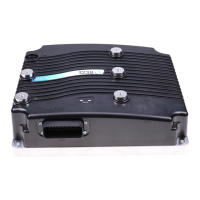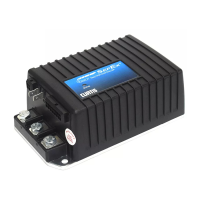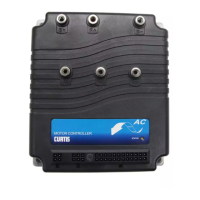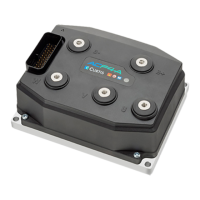Curtis PMC 1209B/1221B/1221C/1231C Manual
43A-2
APPENDIX A
LOGIC SECTION
B- is the ground return for all of the logic and auxiliary circuitry. For systems over 12 volts, the battery supply
is regulated down to 14 volts to power the logic circuitry. The output of the 14 volt regulator is switched on
and off (switch) by the keyswitch input (KSI) to power up the control circuitry when the vehicle is in use and
to power it down (shutdown) when the vehicle is not in use.
The speed control input (throttle input) is usually a 5000 ohm, two-wire pot, but other types can be
accommodated, so a flexible throttle input scaling circuit conditions the control input to a standard level. This
standardized throttle input goes to the acceleration circuit, which limits the rate at which the controller
output can increase. The acceleration rate is set by a resistance, and is adjustable via a user accessible trimpot
(acceleration ramp adjust).
The output of the throttle input scaling also goes to a pot fault circuit, which turns the controller output off
in the event of inputs (e.g., broken wires) that would otherwise cause a runaway. An optional protective
feature, high pedal disable (HPD), inhibits controller output if the controller is turned on with the throttle
applied. After an interval measured (start-up timer) from the moment the KSI input is turned on, the HPD
circuit checks the throttle position. If an applied throttle condition is detected, controller output is held off
until the throttle input is returned to zero and then normal operation is allowed.
The control signal then goes to the limit integrator, which reduces the controller output in response to
undervoltage, overvoltage, or overcurrent. The time-averaged response of this circuit gives a stable limiting
action. The throttle output from the limit integrator is also fed to the oscillator to determine the operating
frequency. On “C” models, the controller operates at 1.5 kHz for throttle requests less than 15% output and
at 15 kHz for throttle requests greater than 15% output. The undervoltage detector gives an output when the
battery voltage is too low. The reduction in output allows the battery voltage to recover and an equilibrium
to be established at a voltage high enough to allow the controller to function properly. The overvoltage
detector produces an output when battery voltage is too high (e.g., overcharged batteries) to protect the
controller from excessive voltage transients. The current limit function is explained in more detail below.
The heart of the logic circuitry is the pulse width modulator in which the control input derived from the
previous stages is compared in magnitude to a 15 kHz sawtooth wave from the oscillator. The resulting pulse
output can be smoothly varied between full off and full on. These pulses become the input to the controller’s
main power MOSFET switch via a gate drive circuit that provides the high pulse currents needed to turn the
power MOSFETs on and off (see Fig. B-1). The shape of the sawtooth wave can be altered so that most of
the pulse width change occurs in the earlier or in the latter part of the control input range, giving more
sensitive throttle response at high or at low speeds.
Current limiting is done by sensing the voltage drop across the main power MOSFET switch when it is on.
This voltage is compared (current limit comparators) with a current limit reference; when it exceeds the
reference, an overcurrent signal acts on the limit integrator to reduce the controller output and thus hold the
current at the limit. Because the voltage across the power MOSFET switch is high when it is off, the current
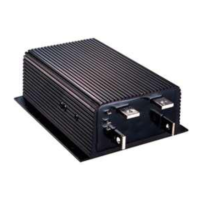
